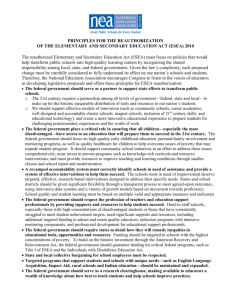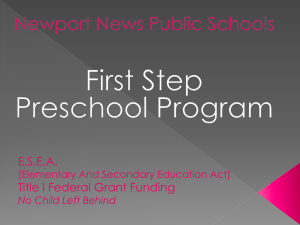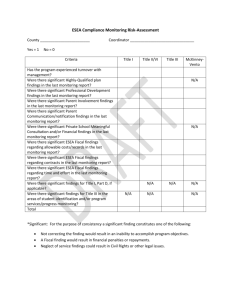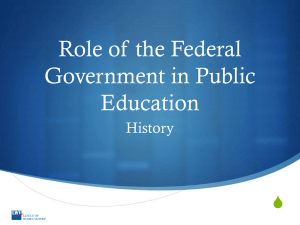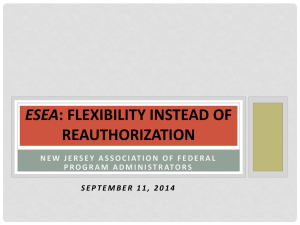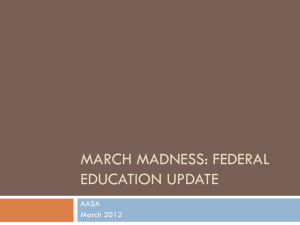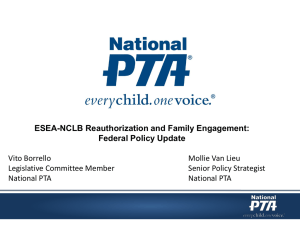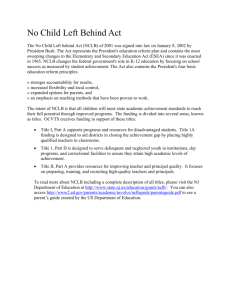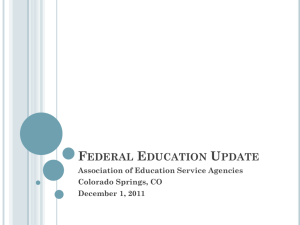Federal Policy Update PowerPoint
advertisement
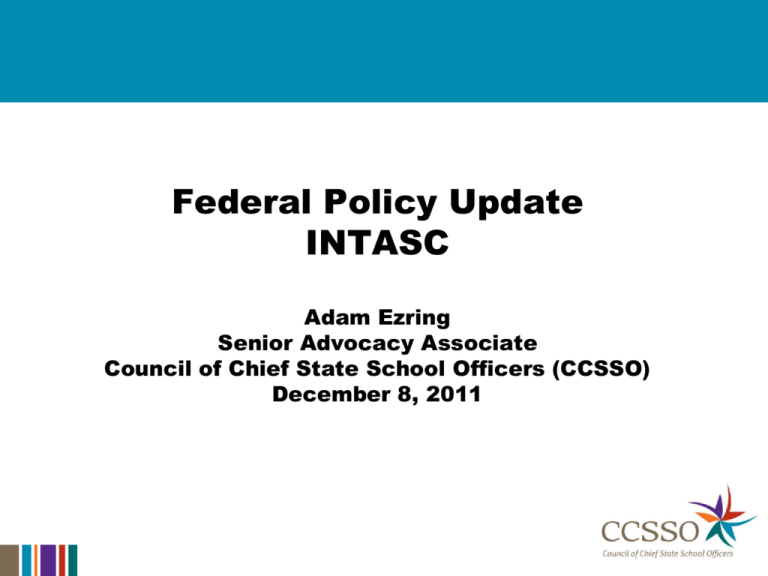
Federal Policy Update INTASC Adam Ezring Senior Advocacy Associate Council of Chief State School Officers (CCSSO) December 8, 2011 What is Congress Doing? Congressional Leaders are Focused on Completing a Few Key Items Before Leaving Town for the Holidays 3 Key Items on the Congressional Agenda: Extending Unemployment Benefits Extending the Social Security Payroll Tax Credit (reduction in the discretionary spending caps) Completing the Appropriations Process Despite progress by the Senate HELP Committee on ESEA reauthorization, legislation will not be brought to the Senate Floor. Federal Budget: Overview Trivia Question With less than 7 legislative days left in this congressional session, Congress has completed how many of the 12 Appropriations bills? A. B. C. D. 9 5 3 0 Federal Budget: Overview With less than 7 legislative day left in this congressional session, Congress has completed how many of the 12 Appropriations bills? The Answer is: C. 3 Federal Budget: Overview The Continuing Resolution funding the federal government expires on Dec. 16th. Includes 1.5% Cut = $329 Million Cut to Title I, Title II, CTE and IDEA Congress Has Only Completed 3 of 12 Appropriations Bills Only 5/6 Legislative Days Left. Omnibus/Megabus for 8 of 9 (Thursday Night) Labor/HHS/Education Most Contentious – Funds Obamacare House Proposal Cuts SIG Completely, Bumps Title I and IDEA Another CR Until February – Post Holiday Cheer? The (Not So) “Super Committee” Trivia Question CBO Projects how much funding will be cut from the Department of Education? A. 1.5B B. 2.5B C. 3.5B The (Not So) “Super Committee” CBO Projects how much funding will be cut from the Department of Education? The Answer Is: C. 3.5B The (Not So) “Super Committee” The “Super Committee” tasked with identifying $1.5T failed to come to agreement. Mandatory Across-the-Board Cuts Go Into Effect January 2nd, 2013 CBO Projects 7.8% Cut = $3.5 Billion from Education $1.12 Billion from Title I, $192 Million from Title II State Grants NGA Projects 8.8% Cut, CBPP Projects 9.13% Cut = $4.1 Billion Efforts to Amend Sequestration will Persist Over Next Year ESEA Reauthorization The Senate HELP Committee Passed A Comprehensive Reauthorization Bill but Unfortunately Further Progress is Unlikely in the Near Future Favorable Committee Vote (15-7). Bipartisan with Enzi, Alexander and Kirk. Report Language Being Developed Admin Rumored Opposition in favor of Waiver Package Harkin Challenge to House of Representatives House Title I/Title II Still Unknown Quantity ESEA Reauthorization: Overview The Senate HELP Committee Legislation is Very Favorable to State Departments of Education. Improvement Throughout Congressional Process Broad Discretion in the Design of Accountability Systems/Consistent with CCSSO’s Efforts Around Next Generation Accountability Maintains 4% State Set-Aside with Title I Consolidated 16 Programs Into 4 Broader Funding Streams New State Determined Turnaround Model Option No Prescriptive Definition of Student Growth ESEA Reauthorization: Title II Trivia Question True or False, Title II of the Senate bill includes a requirement that states develop Teacher and Leader Evaluation Systems in order to Receive Title II Funds? ESEA Reauthorization: Title II Trivia Question True or False, Title II of the Senate bill includes a requirement that states develop Teacher and Leader Evaluation Systems in order to Receive Title II Funds? ESEA Reauthorization: Title II Key Components of Senate Proposed Title II Formula Grants to State (Note: Change), 95% of Funds to LEAs Primary Purposes – TLE system development, PD, Equitable Distribution (Using TLE if Available) Can Also be Used to Recruit, Prepare, Support, Reward and Retain Can be Used to Reduce Class Size (Pre-k to 3rd Only) At least 2% of State-level Title II Funds Set-Aside for Improvement of Principal Performance/HQ Distribution Formally Authorizes TIF Program (Recipients must develop or expand TLE system meeting certain criteria) Establishes New Teacher Pathways Program Supporting Activities for High-Need Subjects in High-Need Schools NCLB Waivers: Overview Elementary and Secondary Education Act (ESEA) talks are unlikely to result in rapid reauthorization, making NCLB waivers the most likely path to accountability system reform. On September 23, President Obama announced that USED is formally inviting states (on a voluntary basis) to apply for "ESEA flexibility" (under NCLB 9401 waiver authority) in exchange for state leadership on several college and career ready reforms, including new accountability systems. 11 States Submitted First Round Applications. Now in Peer Review Feb. 21st Second Round Due Dates NCLB Waivers: 3 Components To Receive a Waiver States Must: 1. College and Career-Ready Standards and Assessments for All Students A. Adopt college and career-ready standards (in at least reading/language arts and math) B. Transition to college and career-ready standards C. Develop and administer annual, statewide, aligned assessments that measure student growth in knowledge and skills 2. State-Developed, Differentiated Systems of Recognition, Accountability, and Support A. Develop and implement a state-based system of differentiated recognition, accountability, and support B. Set ambitious but achievable annual measurable objectives C. Identify Reward Schools (highest-performing) D. Identify Priority Schools (lowest-performing), including new turnaround principles E. Identify Focus Schools (achievement gaps/lowest-performing subgroups) F. Provide incentives and supports for other Title I schools 3. Supporting Effective Instruction and Leadership through Educator Evaluation A. Develop and adopt guidelines for teacher and principal evaluation and support systems B. Ensure LEAs implement evaluation and support systems 4. Reducing Duplication and Unnecessary Burden Key Comparison NCLB Waiver Package Senate Legislation 100% Proficiency for All Students by 2014-2015 School Year 3 Options of Performance Targets Continuous Improvement toward College and Career Readiness Reform Activities for All Schools that Miss Annual Targets Intervention Focused on Bottom 5% of Schools and 10% of Schools with Largest Achievement Gaps/Subgroups. (Multiple Measures) Intervention Focused on Bottom 5% of Schools and 5% of Schools with Largest Achievement Gaps/Subgroups (Assessments/GR) Highly Qualified Teacher Requirement Requirement of Teacher and Leader Evaluation Systems, Based in Significant Part on Student Achievement Teacher and Leader Evaluation Systems Optional via Competitive Grant Program Other News Of Note USED Policy Brief on Title I Comparability Schools serving low-income students are being shortchanged through inequitable distribution of state and local funds. More than 40 percent of Title I schools had lower personnel expenditures per pupil than the non-Title I schools. More than one-third of higher-poverty schools had lower perpupil personnel expenditures than lower-poverty schools. USED Releases Final FERPA Regulations Published Friday Dec. 2nd, Into Effect Jan. 3rd To Foster More Comprehensive Use of Student Data for Research, Evaluation, Accountability and Improvement Balancing Data Access with Privacy Protections Questions? Reactions? Adam Ezring Senior Advocacy Associate Council of Chief State School Officers – www.ccsso.org Email: adame@ccsso.org
